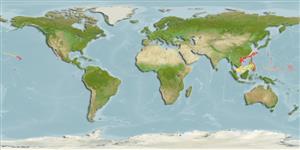Teleostei (teleosts) >
Acanthuriformes (Surgeonfishes) >
Chaetodontidae (Butterflyfishes)
Etymology: Chaetodon: Greek, chaite = hair + Greek, odous = teeth (Ref. 45335).
Eponymy: Spencer Wilkie Tinker (1909–1999) was a malacologist who became the second Director of the Waikiki Aquarium, Honolulu (1940–1973). [...] (Ref. 128868), visit book page.
More on author: Schultz.
Environment: milieu / climate zone / depth range / distribution range
Ecology
Marine; reef-associated; depth range 27 - 180 m (Ref. 89972). Tropical; 28°N - 4°N
Pacific Ocean: formerly known to be endemic to the Hawaiian Islands. Recorded from Johnston Island (Ref. 11013) and the Marshall Islands (Ref. 5439). Replaced by Chaetodon declivis in the Line and Marquesan Islands (Ref. 37816).
Size / Weight / Age
Maturity: Lm ? range ? - ? cm
Max length : 15.0 cm TL male/unsexed; (Ref. 9710)
Often found in the vicinity of steep slopes, solitary or in pairs and occasionally in small aggregations (Ref. 4858). Benthopelagic (Ref. 58302). Feed on a variety of planktonic and benthic organisms (Ref. 4858). Oviparous (Ref. 205). Form pairs during breeding (Ref. 205). High-priced aquarium export (Ref. 37816).
Life cycle and mating behavior
Maturity | Reproduction | Spawning | Eggs | Fecundity | Larvae
Form pairs during breeding (Ref. 205).
Myers, R.F., 1991. Micronesian reef fishes. Second Ed. Coral Graphics, Barrigada, Guam. 298 p. (Ref. 1602)
IUCN Red List Status (Ref. 130435: Version 2024-1)
Threat to humans
Harmless
Human uses
Fisheries: commercial; aquarium: commercial
Tools
Can't connect to MySQL database fbquizv2. Errorcode: Too many connections
